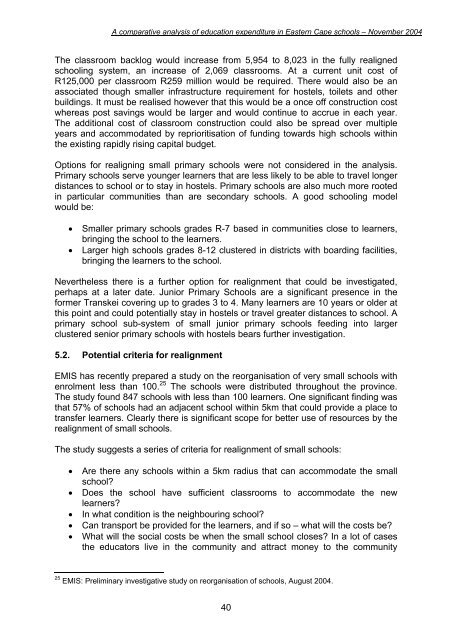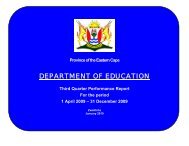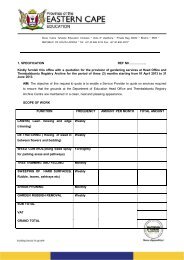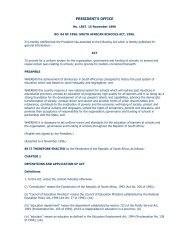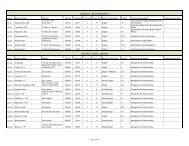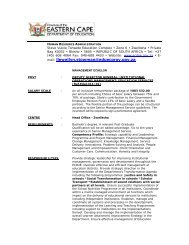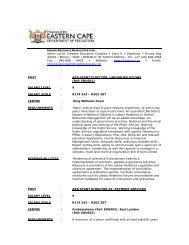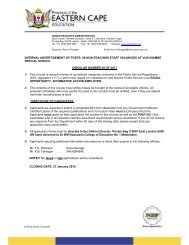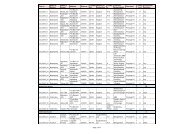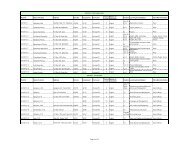School Community Integration Pilot Project - Department of Education
School Community Integration Pilot Project - Department of Education
School Community Integration Pilot Project - Department of Education
Create successful ePaper yourself
Turn your PDF publications into a flip-book with our unique Google optimized e-Paper software.
A comparative analysis <strong>of</strong> education expenditure in Eastern Cape schools – November 2004<br />
The classroom backlog would increase from 5,954 to 8,023 in the fully realigned<br />
schooling system, an increase <strong>of</strong> 2,069 classrooms. At a current unit cost <strong>of</strong><br />
R125,000 per classroom R259 million would be required. There would also be an<br />
associated though smaller infrastructure requirement for hostels, toilets and other<br />
buildings. It must be realised however that this would be a once <strong>of</strong>f construction cost<br />
whereas post savings would be larger and would continue to accrue in each year.<br />
The additional cost <strong>of</strong> classroom construction could also be spread over multiple<br />
years and accommodated by reprioritisation <strong>of</strong> funding towards high schools within<br />
the existing rapidly rising capital budget.<br />
Options for realigning small primary schools were not considered in the analysis.<br />
Primary schools serve younger learners that are less likely to be able to travel longer<br />
distances to school or to stay in hostels. Primary schools are also much more rooted<br />
in particular communities than are secondary schools. A good schooling model<br />
would be:<br />
• Smaller primary schools grades R-7 based in communities close to learners,<br />
bringing the school to the learners.<br />
• Larger high schools grades 8-12 clustered in districts with boarding facilities,<br />
bringing the learners to the school.<br />
Nevertheless there is a further option for realignment that could be investigated,<br />
perhaps at a later date. Junior Primary <strong>School</strong>s are a significant presence in the<br />
former Transkei covering up to grades 3 to 4. Many learners are 10 years or older at<br />
this point and could potentially stay in hostels or travel greater distances to school. A<br />
primary school sub-system <strong>of</strong> small junior primary schools feeding into larger<br />
clustered senior primary schools with hostels bears further investigation.<br />
5.2. Potential criteria for realignment<br />
EMIS has recently prepared a study on the reorganisation <strong>of</strong> very small schools with<br />
enrolment less than 100. 25 The schools were distributed throughout the province.<br />
The study found 847 schools with less than 100 learners. One significant finding was<br />
that 57% <strong>of</strong> schools had an adjacent school within 5km that could provide a place to<br />
transfer learners. Clearly there is significant scope for better use <strong>of</strong> resources by the<br />
realignment <strong>of</strong> small schools.<br />
The study suggests a series <strong>of</strong> criteria for realignment <strong>of</strong> small schools:<br />
• Are there any schools within a 5km radius that can accommodate the small<br />
school?<br />
• Does the school have sufficient classrooms to accommodate the new<br />
learners?<br />
• In what condition is the neighbouring school?<br />
• Can transport be provided for the learners, and if so – what will the costs be?<br />
• What will the social costs be when the small school closes? In a lot <strong>of</strong> cases<br />
the educators live in the community and attract money to the community<br />
25 EMIS: Preliminary investigative study on reorganisation <strong>of</strong> schools, August 2004.<br />
40


